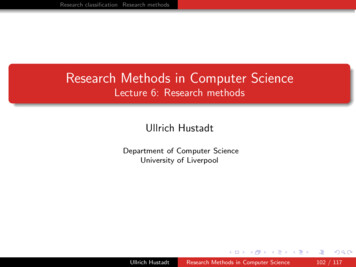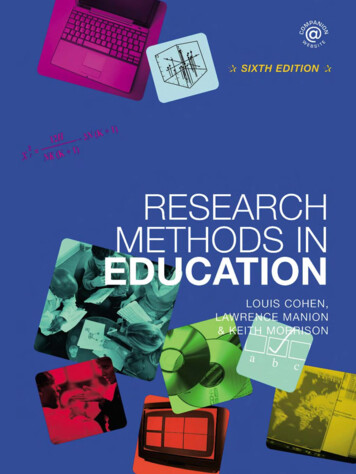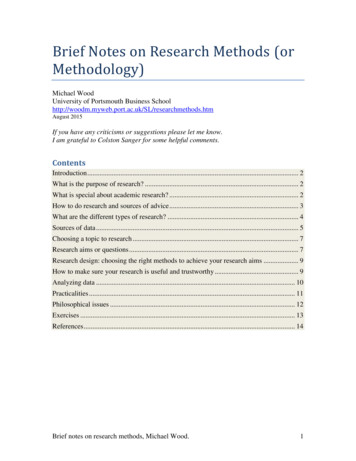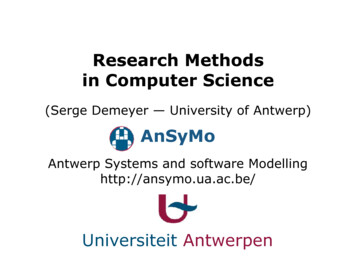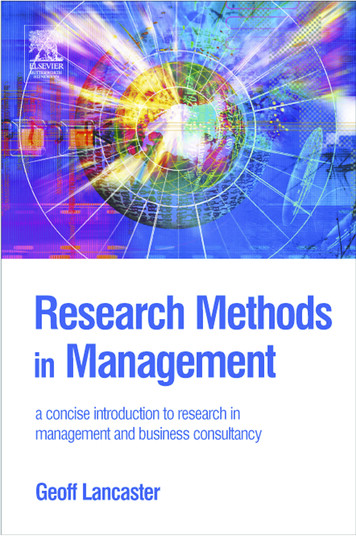
Transcription
Research Methods in Management
This Page Intentionally Left Blank
Research Methods in ManagementA concise introduction to research inmanagement and business consultancyGeoff LancasterAMSTERDAM BOSTON HEIDELBERG LONDON NEW YORK OXFORDPARIS SAN DIEGO SAN FRANCISCO SINGAPORE SYDNEY TOKYO
Elsevier Butterworth-HeinemannLinacre House, Jordan Hill, Oxford OX2 8DP30 Corporate Drive, Burlington, MA 01803First published 2005Copyright 2005, Geoff Lancaster. All rights reservedThe right of Geoff Lancaster to be identified as the author of this workhas been asserted in accordance with the Copyright, Designs andPatents Act 1988No part of this publication may be reproduced in any material form (includingphotocopying or storing in any medium by electronic means and whetheror not transiently or incidentally to some other use of this publication) withoutthe written permission of the copyright holder except in accordance with theprovisions of the Copyright, Designs and Patents Act 1988 or under the terms ofa licence issued by the Copyright Licensing Agency Ltd, 90 Tottenham Court Road,London, England W1T 4LP. Applications for the copyright holder’s writtenpermission to reproduce any part of this publication should be addressedto the publisherPermissions may be sought directly from Elsevier’s Science & Technology RightsDepartment in Oxford, UK: phone: ( 44) 1865 843830, fax: ( 44) 1865 853333,e-mail: permissions@elsevier.co.uk. You may also complete your request on-line viathe Elsevier homepage (http://www.elsevier.com), by selecting ‘Customer Support’and then ‘Obtaining Permissions’British Library Cataloguing in Publication DataA catalogue record for this book is available from the British LibraryLibrary of Congress Cataloguing in Publication DataA catalogue record for this book is available from the Library of CongressISBN 0 7506 6212 3For information on all Elsevier Butterworth-Heinemann publications visitour website at http://www.books.elsevier.comTypeset by Newgen Imaging Systems (P) Ltd, Chennai, IndiaPrinted and bound in Great Britain
ContentsAbout the AuthorAcknowledgementsixxi1 Introduction1.1 Background and major themes1.2 Using this book1.3 Chapter structure/studying each chapter1.4 The research/consultancy project1.5 Concluding comments1135682 Managing Your Development as a ManagerLearning outcomes2.1 The importance of continued professionaldevelopment for the manager2.2 Approaches to professional development:self-development2.3 Action learning: process and principles2.4 Working with and learning from others2.5 Planning a self-development programme2.6 Concluding comments2.7 References2.8 Glossary993 Introduction to Research in ManagementLearning outcomes3.1 The theoretical antecedents to management research:epistemological versus ontological orientations3.2 Deductive versus inductive research3.3 Nomothetic versus ideographic research3.4 Problems and issues in managementconsultancy-type research1011131414181919202021222730
viContents3.53.63.7Concluding CommentsReferencesGlossary4 Management Consultancy and ResearchLearning outcomes4.1 The consultant and consultancy: developmentand meaning4.2 Why organizations use consultants: advantagesand contributions4.3 Disadvantages and limitations of management consultants4.4 Management consultancy – types, roles andactivities4.5 Non-directive versus directive consultancy models4.6 Other Styles of consulting4.7 Internal versus external consultants4.8 Developments in management consultancyapproaches and techniques4.9 Professional and ethical issues in managementconsultancy and research4.10 Concluding comments4.11 References4.12 Glossary333434363637384042434447474849505051515 The Consultancy Research ProcessLearning outcomes5.1 Management consultancy and research:an overview5.2 Initiating the consultancy/research process:meeting/identifying the client5.3 The consultancy research project/topic5.4 Planning and agreeing the consultancy/research brief5.5 Designing and agreeing to the research plan5.6 Completing the consultancy cycle5.7 Concluding comments5.8 References5.9 Glossary53565960616262636 An Overview of Data Collection: Approaches,Methods and TechniquesLearning outcomes6.1 Data, information and decisions6.2 Types of data6.3 Methods of data collection6.4 Issues in data collection6.5 Choosing between data collection methods6464656568697452
Contents6.66.76.8Concluding commentsReferencesGlossaryvii7777787 Data Collection: Secondary DataLearning outcomes7.1 Secondary data: meaning and scope7.2 Planning secondary data collection7.3 Internal secondary data7.4 External secondary data7.5 Criteria for evaluating secondary data7.6 Concluding comments7.7 References7.8 Glossary797980828587929494958 Data Collection: Observational ResearchLearning outcomes8.1 The nature and purpose of observationalresearch8.2 Observation approaches and techniques8.3 Planning and implementing observationalresearch8.4. Other issues in observational research8.5 Concluding comments8.6 References8.7 Glossary97979 Data Collection: Experimental, Quasi-experimentaland Action ResearchLearning outcomes9.1 The nature and purpose of experimentation:classical experimentation9.2 Structuring experimental research design:key steps9.3 Quasi-experimentation9.4 Action research9.5 Concluding comments9.6 References9.7 Glossary10Data Collection: Asking QuestionsLearning outcomes10.1 Questioning as a means of data collection10.2 Interviews10.3 Questionnaires, surveys and samples10.4 128129129130133137146
viiiContents10.5 Concluding comments10.6 References10.6 Glossary15115215211Analysing DataLearning outcomes11.1 Analysis: nature and roles11.2 The purpose of analysis11.3 Quantitative versus qualitative data analysis11.4 Semiotics11.5 Steps in analysing qualitative data11.6 Issues in and approaches to analysing qualitative data11.7 Concluding comments11.8 References11.9 ng ResearchLearning outcomes12.1 Interpreting and diagnosing research findings,making recommendations and taking decisions12.2 Designing the implementation and action plans12.3 Implementation and follow up12.4 Control and evaluation: disengagement12.5 Concluding comments12.6 References12.7 Glossary176176Appendix I:Appendix II:Appendix III:Appendix IV:Appendix V:IndexActivity SolutionsBibliographyInternet Gateways, Research and Databases,Search Engines and Directories forSocial Science ResearchersAmalgamated GlossaryReferencing and Advice on 5
About the AuthorProfessor Geoff Lancaster MSc, PhD, FCIM, FLCCChairman, Durham Associates Group, Castle Eden, Co. Durham, with officesin London and Hull, UK; Bahrain; Jeddah and Dhahran, KSA; Dubai, UAE;Kish, Iran; Muscat, Oman; Doha, Qatar; Lusaka, Zambia and Johannesburg,South Africa. The company was established in 1990 to engage in business consultancy and education. An international division was established in 1994, andthe company received the Queen’s Award for Exporting in 1999.
This Page Intentionally Left Blank
AcknowledgementsI am grateful to the following for permission to use their material:Richard Charlesworth and Peter Morley, London Metropolitan University,for part of Chapter 10 ‘Questionnaire Design’ and ‘Samples and Populations’.David Crowther, London Metropolitan University, for part of Chapter 11‘Semiotics’.John Colby, University of Central England, Appendix V, ‘Referencing and adviceon presentation’.Andy Hollyhead, University of Central England, Advice on ExecutiveSummaries and Reporting.I am grateful to Frank Withey, University of Huddersfield, for the help he hasgiven in terms of providing assistance in the form of advice on the structure ofthe text, for sourcing material and for his critical and constructive evaluation.HollyheadColby
This Page Intentionally Left Blank
1Introduction1.1 Background and major themesThis book was planned and written to fill what was felt to be a distinct gap inthe literature on management research. This recognition came about as a resultof the author’s long experience tutoring undergraduate and postgraduate students completing projects and dissertations for their studies in management.In understanding how to get the best out of this book it would be helpful totrace this background to the development of the book and, in particular, to highlight and explain the major themes in the book and how these serve to differentiate this text from others in the areas of management research andconsultancy.On most undergraduate and postgraduate courses in management, studentsstudying in this area are usually in the final stages of their studies, and arerequired to research in-depth a selected area of management in order to complete a project or dissertation as part of their assessment and award. Althoughthe precise nature and requirements of this research obviously differ between,for example, individual students, the course requirements and the purpose andlevel of the research, on many management programmes students are increasingly being encouraged, and in some cases required, to complete their researchand produce their projects and dissertations based on managerial issues orproblems in a real-life organization.In the case of students studying part-time, or perhaps through distance learning, the organization on which the research/project is based is often the one inwhich the student is working. Perhaps understandably where this is the case,both students and their organizations often welcome this approach as there areclearly advantages to both the student and the organization.In the case of full-time students, although they are not usually employees ofa particular organization, here too students are being increasingly encouragedto develop their managerial skills by conducting their final year projects or dissertation for a real life organization. In this case, students might be allocated to
2Research Methods in Managementselected companies who agreed to provide management problems for studentsto look at.As already mentioned, for both full-time and part-time students an increasing trend is for students to complete their project or dissertation work basedon a real-life management issue in an organization.One of the main advantages of this approach is that at the same time as satisfying the academic requirements in most undergraduate and postgraduateprogrammes to complete an extended in-depth project or dissertation based onresearch, it helps students to develop their skills and expertise as managers.After all, the knowledge developed on most management courses, it can beargued, only becomes useful when it is applied to the real world of organizations and real-life management issues and problems. In order to facilitate thismove towards learning through organization-based management, researchstudents need to acquire skills and knowledge in several key related areas.Management consultancy skillsFirst, students need skills and knowledge in how to plan and conduct what iseffectively a management consultancy exercise. They need to understand theconsultancy process through from how to initiate a management consultancyproject with a client, how to conduct a project, and how to implement, followup and withdraw from the project.Management research skillsSecond, students need skills and knowledge in how to plan and conduct researchin management. In particular they need to understand the main approaches toconducting research in this area, for example, techniques of data collection andanalysis.Self development skillsThird, as perhaps a subsidiary, but nevertheless still important need, studentsalso need to understand and appreciate how the application of managementresearch principles and techniques through a management consultancy exercisecontributes to their development as managers.How these areas relate to the structure and use of this book, and why it wasfelt necessary to write a new text are outlined below. Management consultancy: Where students and/or managers are going to workon real-life management problems with organizations for their projectsand dissertations, they are, as already mentioned, effectively working in aconsultancy capacity.Surprisingly, however, most undergraduate, or even postgraduate coursesin management spend very little time on developing the skills and techniquesof management consultancy. Admittedly, students are taught skills in, say,
Introduction 3marketing research, financial or human resource management, and so on, whichcan later be used if working in a consultancy capacity, but in the context ofmany management courses much of what is taught is often conceptual in naturewith applications being confined to, for example, case study activities. If students are going to be asked to act as management consultants for companiesas part of their studies then it is necessary to address the development of theskills and expertise required for this activity. In fact, there are very few textsavailable in this area, especially when the consultancy is to be linked to thecompletion of a project or dissertation as part of a course of studies in management. Generally, the texts available on management consultancy, excellentthough many of them are, focus on the practising management consultantrather than on the undergraduate or postgraduate student conducting this workto produce a research project or dissertation. It was felt, therefore, that therewas a need for a text which specifically addressed the issues in, and approachesto, using a consultancy-based approach to the process of studying and researching in management, and at the same time, fulfilling appropriate academiccriteria. Consultancy then became the first major theme of this text.Management research: Unlike the management consultancy area, there are literally dozens of excellent texts, designed to introduce students to the conceptsand techniques of research in management. Even in the more specific contextof researching for an undergraduate or postgraduate dissertation or project onmanagement, again there is no shortage of excellent texts on, for example, howto conduct a research project; qualitative and quantitative methods of research;and approaches to completing student research projects and dissertations.However, many of these texts on management research are often very conceptual in nature and rarely are structured around a consultancy-basedapproach. The uses and application of the main techniques of managementresearch to real-life management issues and problems centered on a consultancy-type project then became the second theme of the text.Self development: It is increasingly recognized that, having completed theircourses and studies, managers in today’s environment will nevertheless needto constantly develop and refine their skills during their careers in management.A major advantage of conducting a research project through a consultancy-typeapproach in an organization is that it can be a major vehicle, not only for developing the sorts of management and executive skills needed for today’s manager,but in addition, can serve to promote self-development through action learningwhich in turn leads to an understanding of the nature and processes of continued professional development throughout a manager’s life in organizations.This idea of self-development, then, is one that runs throughout this text andis, therefore, the third key theme of the text.1.2 Using this bookThe aim of this book is to help you become competent in the process ofmanagement and consultancy research activities. In achieving this aim the
4Research Methods in Managementtext encompasses the skills and procedures of consultancy research. Theseencompass the steps in the consultancy process ranging through from initiating, planning and designing consultancy research projects through to the methods and skills of data collection and analysis. The key processes of implementingand actioning consultancy research findings in client organizations are alsocovered.It is envisaged that most readers using this text will be completing a projector dissertation as part of their studies through the practical application of amanagement consultancy project in a selected organization. The text, therefore,also aims to help develop your management competence and expertize throughbecoming an active part of the organizational world, thereby acquiring transferable skills needed for personal and professional development throughoutyour life as a manager.In Chapter 2, you will be introduced to the importance of managing yourdevelopment and learning as a manager and, in particular, the importance ofself-development and learning through the completion of a consultancy-typeproject in an organization. Development and learning in this way is, as we shallsee, often referred to as ‘action learning’. In order to get maximum benefit fromthe use of the book, it is important to familiarize yourself with the action learning process and principles outlined in this chapter. In addition, in this chapteryou will also be introduced to the steps in planning a self-development programme to assess your own personal needs for development as a manager.Because of this, Chapter 2 differs slightly in approach to the subsequent chapters in the book. You will be required to consider your own development needsas a manager perhaps working together with a mentor, or possibly your project/research supervisor. This in turn will require you to consider the key managerial skill areas and your strengths and weaknesses in each of these. You willthen be asked to set personal objectives for your self-development as a manager. Finally, having considered your own personal development objectives,you are asked to consider the selection and design of a consultancy-type researchproject which will help towards the achievement of your identified management self-development objectives.You may be tempted to omit this part of the chapter on self-development andinstead move on to the design of a consultancy-based project and the techniquesof management research. However, it is useful to remember that one of the keythemes in the book is using management research and consultancy to developthe sort of management and executive skills needed to survive in the complexand ever changing business world of today and the future. The ideas and frameworks developed in this chapter therefore are relevant to all the stages of theconsultancy research process from the perspective of self-development andtherefore it may be useful to return to this chapter from time to time as youwork through the research process.In Chapter 3 you are introduced to research in management. The chapter compares and contrasts the different theoretical stances in the practice of research;the overall management research process, the different approaches to conducting management research and the relationship between management research,management development and management consultancy. You should use this
Introduction5chapter to familiarize yourself with the main traditions and approaches toconducting research. In some ways, this is the most conceptual chapter in thebook, but it is vital to developing your understanding of the main researchapproaches in management and how they relate to research through consultancy.Chapters 4 and 5 together explain the nature and process of managementconsultancy and research encompassing the nature, purposes and issues of thisprocess and the key steps involved. Obviously, when you come to initiate andplan your consultancy project these two chapters are vital to these processes.Chapters 5–11 encompass the main methods of data collection and analysis inmanagement research. Obviously a key choice in research is the method(s) ofdata collection. Which of these chapters will prove to be most useful and relevantto your particular research will of course, depend on the choice you make of theappropriate data collection methods. This choice, requires you to be familiar withthe alternative approaches to data collection and analysis and therefore, thesechapters not only provide this familiarization but also help in selecting and applying the research techniques which are most appropriate for any given consultancy research project. For readers who are conducting more traditionalnon-consultancy-type management research projects, these chapters can be usedas stand alone chapters covering the main methods of data collection and analysis.In the final chapter of the text – Chapter 12 – we look at the process of moving from data analysis to using this analysis to make recommendations anddecisions about courses of action. Because the approach taken throughout thetext centers on conducting management and consultancy research, this chapterintroduces the key considerations regarding consultancy proposals to clientsand how, at the end of a consultancy project, the consultant can disengage fromthe client system and leave the internal managers in the organization to continuemanaging on their own. Again, readers who are not adopting a consultancybased approach may be tempted to omit Chapter 12. However, as the logicalconclusion to most management research processes is the determination of recommended courses of action and as this aspect of a management research project is included in this chapter, most of you will find this final part of the bookessential reading.On completion of the book you will be able to: engage in management consultancy and research, using a range of appropriate tools and techniques of management research;manage a strategic project from its conception to the presentation of an executive report;monitor your own development as a manager during the execution ofconsultancy-type project work.1.3 Chapter structure/studying each chapterWith the exception of Chapter 1 which for reasons explained in the chapteritself differs slightly from the other chapters, the remaining chapters have anumber of common structural elements designed to help you get the maximum
6Research Methods in Managementbenefit out of reading and studying the chapter. The main structural elementsinclude the following:Learning OutcomesEach chapter includes a set of learning outcomes designed to highlight whatskills and knowledge the chapter is designed to cover and which, on completion of the chapter, you should you have learned.Activities/activity debriefsMany of the chapters will, at the appropriate juncture, ask you to undertakesome sort of activity. These take a number of forms, but essentially are designedto reinforce the learning process by asking you to apply key concept, provideanswers to questions, reflect on key learning points, and so on. Obviously it isup to you to decide whether or not to complete these activities – and indeedhow much time and effort you want to devote to them. However, you will findthat completing these activities will provide valuable insights and serve to helpyou understand key concepts and techniques and you are therefore advised tocomplete the activities. In the Appendix to the book you will find a set of activity debriefs which explain the activities and, where appropriate, provide solutions. Again, how you use the activity debriefs is up to you, but ideally youshould try to complete an activity before consulting the corresponding debrief.References/GlossaryAlthough the book is designed to be self-contained, as you would expect, youare encouraged to read as widely as possible. To this effect each chapter contains specific references to help you explore and expand your knowledge in keyareas. In addition, key words and terms introduced in the chapter are explainedin a glossary section at the end of each chapter.1.4 The research/consultancy projectRemember that a key distinguishing feature of this book is that the content andstructure are based around, and are primarily intended to be applied to, a management-consultancy-type project that users of the book will select and workon. For many, this project will also underpin the completion of a project reportor dissertation as part of a programme of studies. Obviously then, the natureand organization of the consultancy project will have a major effect on how thisbook is used. In particular, major factors influencing the use of the book willinclude, for example: the choice of consultancy/research topic, the type of consultancy client, the nature of the relationship between consultant and client, andso on. In addition, where the research is part of a programme of study leadingto an award of some kind, then the use of the book will also vary according to
Introduction7the precise nature and role of the research project, the level of the award, thetime scale, arrangements for supervision, whether the project is individual orgroup work, reporting procedures, marking criteria, and so on.Clearly, with so many factors influencing precisely how the book will be bestused, it is impossible to prescribe how you should work through and use thevarious chapters. No doubt, where appropriate, you will be discussing detailssuch as project selection and approval, client selection, precise objectives, methods of working, research framework, timetables and so on with a project/research supervisor. As an overall guide, however, the book links up to the completion of a research project or dissertation together with a planned programmeof professional self-development as follows: initiating, planning and the consultancy project: including initial discussionswith a project/dissertation supervisor;design and agreement of research proposal;conducting the consultancy project/feedback from supervisor;completing the consultancy report;planning an ongoing process of monitoring professional self development.If you are using this book in order to complete an actual research project,then clearly you will have to manage the above mentioned activities within thetime allocated to them. How many hours will be required to complete eachchapter in the book is suggested below. The remaining time will be taken upby the other activities already mentioned, and together will account for mostof the time required to complete a research project. Obviously, allocations andrequirements regarding planning study time should be discussed individuallywith a project supervisor and any client organization according to circumstances.Chapter 2 Managing your development as a managerThe importance of and approaches to manager andexecutive development. Identifying and planning selfdevelopment needsChapter 3 Introduction to research in managementThe nature, scope and purpose of management researchChapter 4 Management consultancy and researchThe nature, purposes and issues of consultancy researchChapter 5 The consultancy research processKey issues and steps in initiating, planning, designingand conducting a management consultancy projectChapter 6 Data collection: an overviewThe range of data collection methodsChapter 7 Data collection: secondary dataMeanings, sources and uses of secondary dataChapter 8 Data collection: observational researchTechniques, uses and limitations3 hours3 hours3 hours3 hours3 hours3 hours3 hours
8Research Methods in ManagementChapter 9 Data collection: experimental,quasi-experimental and action researchTechniques, uses and limitationsChapter 10 Data collection: asking questionsTechniques, uses and limitationsChapter 11 Analysing dataTechniques and approachesChapter 12 Actioning researchCreating action from research findings: diagnosis,recommendations, decision making completing andterminating consultancy projects3 hours3 hours3 hours3 hours1.5 Concluding commentsIn this introductory chapter I have explained the background to the design ofthe book. In so doing, I have also highlighted the major themes which runthroughout. The overall aim of the book is to help you become competent in theprocess of management and consultancy research activities. I have outlined thenature and content of each chapter, and the role each chapter plays in the development of your competencies in research and consultancy, and I have givensome suggestions as to how many hours will be required to complete eachchapter in the book, including the activities which are an essential part of eachchapter.Finally, I have added my opinion by way of an acknowledgement regardingthe difficulties and frustrations of conducting consultancy-type-based research,and now proffer some suggestions as to how to minimize these.After many years’ experience of this type of research you are warned that thepath of such research hardly ever runs smoothly and is fraught with pitfalls forthe inexperienced or unwary. There is no doubt that you will make mistakes.You will certainly experience unexpected problems and roadblocks. Who knows,but along the way you may even make some enemies. All research is potentiallycomplex and, at times, frustrating. The only solution to these problems is goodresearch design; a systematic and planned approach; and finally perseveranceand patience. Remember that applied/consultancy research in particular, largelybecause of the challenges it poses, is one of the most satisfying and rewardingways of learning about management and organizations. You are assured thatwith perseverance and patience no other element of your learning and studieswill potentially contribute more to your self development as a manager, andpossibly senior executive of the future, than the activities and skills which areencompassed here. In the next chapter then, you are introduced to the processof managing your development as a manager and the role which a consultancytype research project plays in this.
2Managing YourDevelopment as aManagerLearning outcomesAfter completing this chapter you will understand: the importance of, and approaches to
4.4 Management consultancy – types, roles and activities 42 4.5 Non-directive versus directive consultancy models 43 4.6 Other Styles of consulting 44 4.7 Internal versus external consultants 47 4.8 Developments in management consultancy approaches and techniques 47 4.9 Professional and ethical issues in managem

